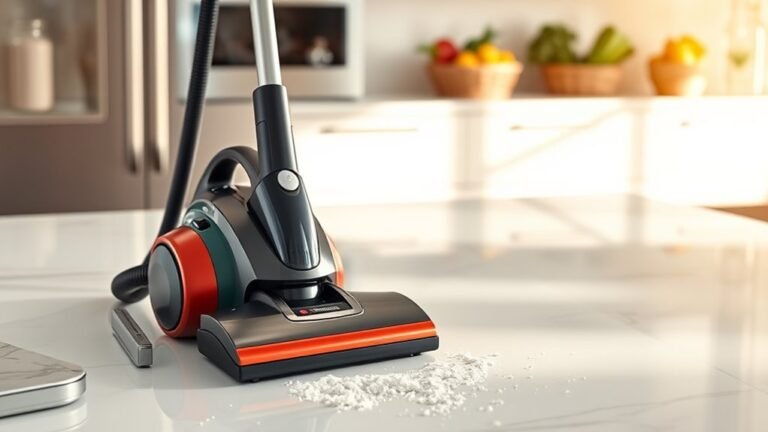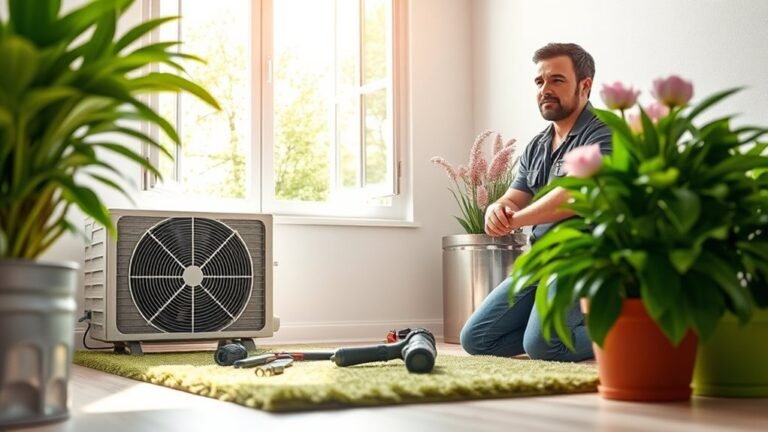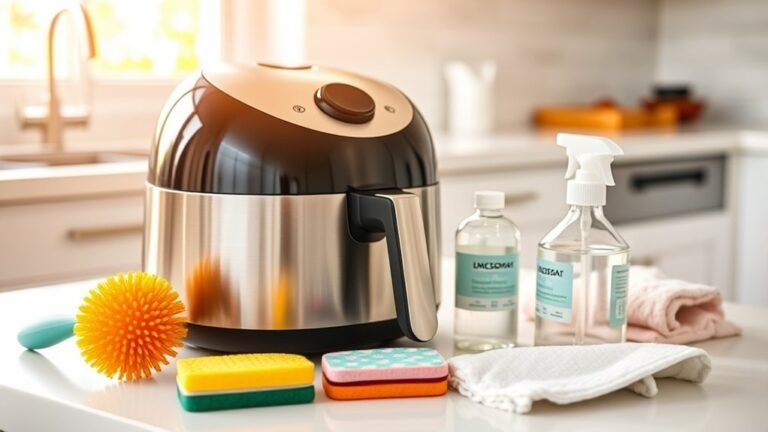Using Steam Mops for Deep Cleaning Floors
Using a steam mop lets you deep clean floors quickly using only water and heat, without harsh chemicals. It sanitizes by killing germs and loosening dirt from cracks, especially on tile or sealed hardwood. Before you start, clear and dry your floor for the best results. With steam mops, you save time and get a thorough clean that keeps floors looking fresh longer. Keep going for tips on choosing, using, and caring for your steam mop.
Benefits of Using Steam Mops for Floor Cleaning
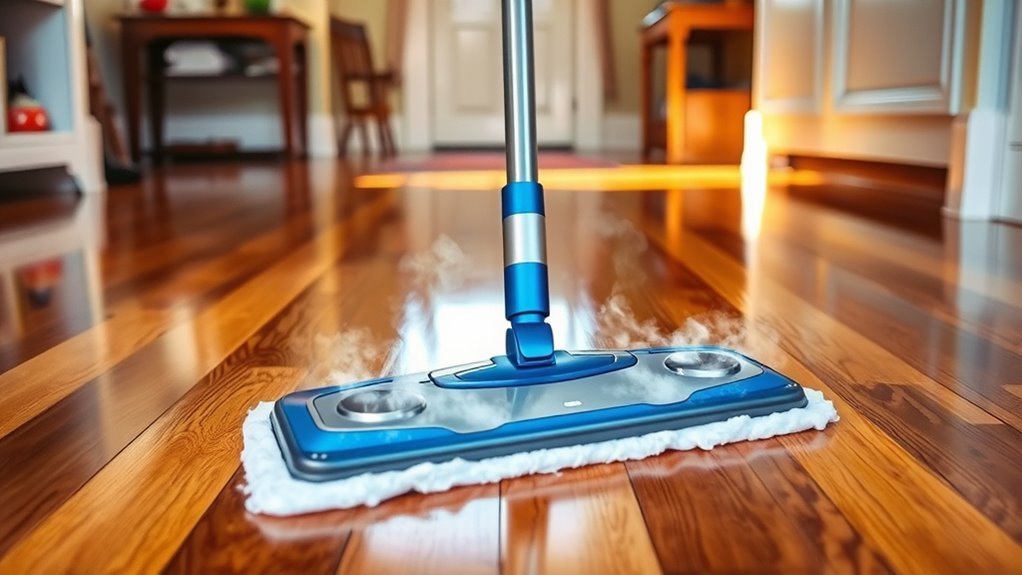
Although traditional mopping gets the job done, using a steam mop can make floor cleaning faster and more effective. You’ll appreciate the steam mop advantages that free you from harsh chemicals, allowing you to clean with just water and heat. This means fewer toxins in your home and less time scrubbing stubborn grime. The deep cleaning benefits are impressive—steam penetrates deep into floors, loosening dirt and killing bacteria, giving you a truly refreshed surface. With a steam mop, you’re not just cleaning; you’re reclaiming your time and energy for what matters most. Embracing this tool means less effort and more freedom, turning a chore into a quick, satisfying task that keeps your floors spotless without the hassle.
Types of Floors Suitable for Steam Mopping
When choosing a steam mop, it’s important to know which floors can handle the heat and moisture without damage. Tile floors are perfect for steam mopping—they’re durable, water-resistant, and the steam helps lift grime from grout lines effortlessly. You’ll love how fresh and clean your tile floors feel after a quick steam session. Hardwood floors, on the other hand, need a bit more caution. If your hardwood is sealed properly, steam mopping can work well, but unsealed or old hardwood might warp or stain with excess moisture. Always check your floor’s finish before using steam. By knowing which floors suit steam mops, you can enjoy a deeper clean without worrying about damage, giving you the freedom to maintain your home with ease.
How Steam Mops Work to Deep Clean Floors
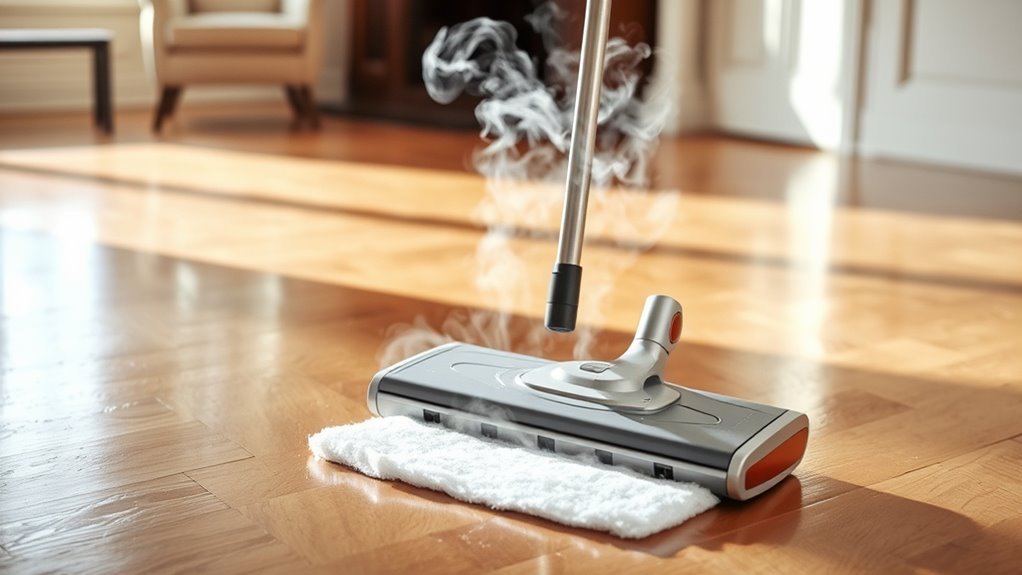
When you use a steam mop, hot steam penetrates deep into the floor’s surface to loosen dirt and grime. This process not only sanitizes by killing bacteria but also helps lift stubborn stains without harsh chemicals. It’s important to know which floor types can handle this intense cleaning method to avoid damage.
Steam Penetration Mechanism
Because steam mops use high-temperature steam, they can penetrate deep into floor surfaces to break down dirt and grime that traditional mopping might miss. The secret lies in the steam pressure, which forces hot vapor into microscopic crevices where dust and buildup hide. This steam moves beyond just the surface, loosening particles without harsh scrubbing. Even heat distribution guarantees every part of your floor gets an equal, powerful clean, preventing spots from being overlooked. When you glide a steam mop across your floor, you’re not just wiping — you’re releasing a controlled burst of heat and moisture that lifts dirt efficiently. This process gives you freedom from stubborn grime with minimal effort, letting you enjoy cleaner floors and more time for what really matters.
Sanitizing and Stain Removal
Although steam mops rely on water and heat rather than chemicals, they’re highly effective at sanitizing floors by killing bacteria and germs on contact. This natural surface sanitization frees you from harsh cleaners while delivering a deep clean. When tackling stain treatment, steam loosens dirt and grime, making it easier to wipe away stubborn spots. To maximize results:
- Pre-treat tough stains with a damp cloth.
- Use the steam mop’s concentrated burst function.
- Move slowly over stained areas for thorough cleaning.
- Allow the floor to dry quickly to prevent residue.
Suitable Floor Types
Steam mops are designed to deep clean a variety of floor types by using high-temperature steam to loosen dirt and grime without damaging surfaces. You’ll find them especially effective on hardwood floors, where gentle steam refreshes the wood without the need for harsh chemicals or excessive water. Tile floors also respond well, as the steam penetrates grout lines, lifting embedded dirt effortlessly. Just remember, not all floors are suited for steam cleaning—laminate or unsealed hardwood may warp or get damaged. Before you start, check your floor’s manufacturer guidelines to keep your freedom intact and avoid costly mistakes. With the right surface, steam mops offer a liberating way to maintain crystal-clear floors without sacrificing time or effort.
Preparing Your Floor Before Steam Mopping

Before you start using your mop, make certain your floor is clear of any debris and loose dirt. Proper floor preparation is key to getting the most out of your steam mop and freeing yourself from endless scrubbing. Start by removing obstacles and then focus on cleaning debris that could block the steam or scratch your floor.
Here’s a quick checklist for effective floor preparation:
- Sweep or vacuum to pick up dust and small particles.
- Move furniture and rugs to access the entire surface.
- Check for sticky spots and pre-treat them with a damp cloth.
- Confirm the floor is dry before steam mopping to avoid excess moisture.
Following these steps lets you steam mop efficiently and keep your floors looking fresh.
Step-by-Step Guide to Using a Steam Mop
Once your floor is properly prepared, you’re ready to start using the steam mop. First, fill the water tank with clean, distilled water to prevent mineral buildup. Plug in your steam mop and allow it to heat up—most models have an indicator light. Begin by pressing the trigger or switch to release steam while moving the mop slowly across the floor in straight lines. Use overlapping strokes for even cleaning. Remember these steam mop tips: don’t hold the mop in one spot too long to avoid damage, and avoid steam on unsealed floors. Embrace steam cleaning techniques like adjusting steam levels for different surfaces and changing mop pads when dirty. This method frees you from harsh chemicals while delivering a deep, revitalizing clean.
Safety Precautions When Using Steam Mops
When using a steam mop, you’ll want to follow proper electrical safety to prevent accidents. It’s also important to avoid damaging delicate floor surfaces by knowing which materials can handle steam. Plus, practicing safe handling techniques will keep you injury-free while cleaning.
Proper Electrical Safety
Using steam mops safely starts with understanding a few key electrical precautions. You want to keep your cleaning freedom without risking electrical overload or accidents. Here’s what to remember:
- Avoid plugging too many devices into one outlet to prevent electrical overload.
- Always inspect the power cord for damage before use; a faulty cord is a hazard.
- Practice good cord management—keep the cord untangled and away from water to avoid trips and shocks.
- Unplug the steam mop when filling water or when not in use to eliminate any risk.
Avoiding Surface Damage
Electrical safety helps keep you protected while cleaning, but protecting your floors from damage is just as important. You’ll want to verify your steam mop compatibility matches your floor type—hardwood, tile, or laminate all respond differently to steam. Using a steam mop not designed for your flooring risks warping or discoloration, so always check the manufacturer’s guidelines. For floor protection, avoid excessive steam or prolonged exposure in one spot to prevent moisture damage. It’s wise to test a small, inconspicuous area first to see how your floor reacts. This way, you maintain your freedom to clean deeply without worrying about ruining your surfaces. Taking these precautions lets you enjoy the benefits of steam cleaning while keeping your floors looking great.
Safe Handling Techniques
Although steam mops make floor cleaning easier, you need to handle them carefully to avoid accidents or damage. To enjoy freedom while cleaning, prioritize safety with these key techniques. First, always maintain a safe grip—hold the mop firmly but comfortably, preventing slips. Second, choose a mop with an ergonomic design to reduce strain on your hands and wrists. Third, keep the cord away from wet areas to prevent electrical hazards. Fourth, never leave the steam mop unattended while it’s plugged in or hot; it’s safer and smarter. Following these steps guarantees you clean effectively without risking injury or floor damage, giving you the freedom to enjoy spotless floors with confidence.
Choosing the Right Steam Mop for Your Needs
How do you find a steam mop that fits your specific cleaning needs? Start by considering steam mop features like water tank size, heat-up time, and maneuverability. You want freedom to clean without constant refills or waiting. Next, explore steam mop brands known for reliability and performance to guarantee your investment lasts.
| Feature | Benefit |
|---|---|
| Large water tank | Longer cleaning sessions |
| Quick heat-up | Saves time |
| Lightweight | Easier handling |
| Adjustable steam | Suitable for various floors |
| Swivel head | Access tight spaces |
Cleaning and Maintaining Your Steam Mop
To keep your steam mop working efficiently, you’ll need to clean and maintain it regularly. Proper steam mop maintenance guarantees your freedom from unnecessary repairs and keeps your floors spotless. Here are four essential cleaning tips:
- Empty and rinse the water tank after each use to prevent mineral buildup.
- Wash or replace mop pads regularly to avoid dirt transfer and maintain cleaning power.
- Wipe down the mop’s exterior and steam nozzles to remove residue and blockages.
- Descale your steam mop monthly using a vinegar-water solution if you live in a hard water area.
Following these steps assures your steam mop stays in top shape, giving you the liberty to deep clean your floors effortlessly whenever you want.
Common Mistakes to Avoid When Steam Mopping
When steam mopping, you’ll want to avoid using too much water since it can damage your floors. Make sure you’re using the right attachments designed for your specific floor type to get the best results. Skipping these steps could lead to poor cleaning or even harm your surfaces.
Avoid Excessive Water
One of the biggest mistakes people make with steam mops is using too much water. Excessive moisture can lead to water retention in your floors, causing damage and long drying times. To keep your floors free and clear, avoid this pitfall by:
- Filling the water tank only to the recommended level.
- Using short steam bursts rather than continuous flow.
- Moving the mop steadily to prevent puddles.
- Letting floors dry completely before walking on them.
Use Suitable Floor Attachments
Controlling water usage is just part of the equation for effective steam mopping; choosing the right floor attachments plays a big role too. You want to pick floor attachment types that match your floor’s needs. Using ideal attachment materials guarantees you don’t damage surfaces and get the freedom to clean confidently. Here’s a quick guide to help you make the best choice:
| Attachment Type | Ideal Material |
|---|---|
| Hard Floors | Microfiber Pad |
| Carpets | Brush Attachment |
| Tiles & Grout | Scrubbing Pad |
| Hardwood | Soft Cloth Pad |
| Delicate Surfaces | Gentle Microfiber |
Selecting the right attachment protects your floors and lets you steam mop without worry, giving you the freedom to enjoy spotless floors.
Enhancing Floor Longevity With Regular Steam Cleaning
Since steam cleaning uses only water vapor without harsh chemicals, it’s a gentle yet effective way to maintain your floors. Regular steam cleaning promotes floor longevity by preserving surfaces without damage. You gain freedom from harsh cleaners and tedious scrubbing, relying on steam effectiveness to keep floors pristine. For ideal floor maintenance, consider these key benefits:
Steam cleaning gently preserves your floors, removing grime without harsh chemicals for lasting beauty and health.
- Removes dirt and grime deeply without abrasive agents
- Kills bacteria and allergens naturally
- Prevents buildup that can wear down floor finishes
- Maintains original floor texture and color longer
Frequently Asked Questions
Can Steam Mops Be Used to Clean Grout Between Tiles?
Imagine you’ve got a trusty quill instead of a smartphone—that’s how steam mops feel old-school yet powerful for grout cleaning. You can definitely use them to freshen up the grout between tiles, making tile maintenance easier and freeing you from harsh chemicals. Just be cautious with delicate grout, as too much steam might cause damage. When used right, steam mops help you reclaim your time and keep your floors looking sharp without much hassle.
How Long Does It Take for Floors to Dry After Steam Mopping?
The drying time after steam mopping usually depends on your floor conditions, like the material and room ventilation. Generally, it takes about 15 to 30 minutes for floors to dry, but if your space is humid or poorly ventilated, it might take longer. You’ll want to let your floors dry completely before walking on them to avoid slipping and to enjoy that fresh, clean freedom without any hassle.
Are Steam Mops Effective Against Pet Odors and Stains?
Coincidentally, when you’re tackling pet odor removal, steam mops can be surprisingly effective. Thanks to the high heat, they don’t just clean—they help eliminate stains and neutralize odors without harsh chemicals. You’ll love the freedom of a fresher home without extra scrubbing or nasty residue. Just remember, stubborn stains might need a little extra attention, but overall, steam mops offer a convenient way to keep your floors smelling clean and looking great.
Can Steam Mops Be Used on Carpeted Surfaces?
You can use steam cleaning on carpets, but it’s not as simple as with hard floors. Steam mops work best for spot cleaning or revitalizing carpet surfaces rather than deep cleaning. For carpet maintenance, you’ll want to be cautious—too much moisture can damage fibers or cause mold. If you’re after freedom from harsh chemicals and want a quick freshen-up, a steam mop can help, but for serious carpet care, consider professional steam cleaning instead.
Do Steam Mops Require Special Water or Cleaning Solutions?
Do you really want to complicate something that’s meant to make cleaning easier? Generally, steam mops don’t need special cleaning solutions—just good water quality matters. Using distilled or filtered water can boost steam efficiency and prevent mineral buildup, extending your mop’s life. So, stick to plain water and enjoy the freedom of a simple, chemical-free clean without worrying about messy additives or costly solutions.



